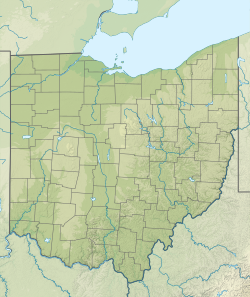Sherith Israel Temple (Cincinnati, Ohio)
| Sherith Israel Temple | |
|---|---|
 The former synagogue, now condominia, in 2007 | |
| Religion | |
| Affiliation | Orthodox Judaism (former) |
| Ecclesiastical or organisational status |
|
| Status | Active |
| Location | |
| Location | Cincinnati, Ohio |
| Country | United States |
Location of the former synagogue in Ohio | |
| Geographic coordinates | 39°06′12.3″N 84°30′45.6″W / 39.103417°N 84.512667°W |
| Architecture | |
| Type | Synagogue architecture |
| Date established | 1855 (as a congregation) |
| Completed | 1860 |
The Sherith Israel Temple is a former Orthodox Jewish congregation and synagogue, located at 624 Ruth Lyons Lane (originally Lodge Street), in the backstage entertainment district in downtown Cincinnati, Ohio, in the United States.
The former synagogue building is the oldest existing synagogue building west of the Allegheny Mountains and the fourth oldest building in downtown Cincinnati. It is the seventh oldest synagogue building in the United States.
History[edit]

The congregation was founded in 1855 as an Orthodox[1] congregation that objected to the Reform tendencies of the Rockdale Temple, then known as K.K. Bene Israel.[2][3] The congregation merged with Congregation Ahabeth Achim in 1906.[3]
The synagogue was built in 1860 and was an active synagogue until 1882.[4] After that the building served as a warehouse, plumbing supply house, and machine shop.
Chris Cain, the city's historic preservation officer said, "This is a building of importance".[citation needed] Officials debated more than a year whether the building, once an Orthodox[1] synagogue, should be saved. Despite the synagogue's history, the City officially decided in 1998 that the building should not be declared "historic".[5][6][7][8]
The former synagogue was saved from demolition, renovated, and, since 2003, houses condominia.[9]
See also[edit]
References[edit]
- ^ a b Greve, Charles Theodore (1904). Centennial history of Cincinnati and representative citizens. Cincinnati: Biographical Publishing Company. p. 945.
- ^ Cincinnati Jewish History, David's Voice
- ^ a b Goss, Charles Frederic (1912). Cincinnati, the Queen City, 1788-1912. Cincinnati: The S. J. Clarke Publishing Company. p. 38.
- ^ Clark, S. J. (1912). Cincinnati, the Queen City, 1788-1912, Volume 2. The S. J. Clarke Publishing Company. p. 39. Retrieved May 20, 2013.
- ^ Sturmon, Sarah (April 4, 1997). "Temple may get reprieve". The Cincinnati Post. E. W. Scripps Company. Archived from the original on January 14, 2005.
- ^ "No historic designation for ex-temple". The Cincinnati Post. E. W. Scripps Company. April 9, 1998. Archived from the original on May 14, 2003.
- ^ "Potential Backstage Buyer Eyes Lost Temple". City Beat. 2008. Archived from the original on July 8, 2011.
- ^ "Future of temple at stake". Cincinnati Inquirer. February 22, 1997.[dead link]
- ^ Jacob, Allyson. "Sherith Israel Synagogue". CityBeat. Retrieved July 10, 2012.
External links[edit]
- "Jewish Cincinnati: A Walk Through History: An historical walking tour" (PDF). ish Festival. Ohio Humanities. n.d.
- 1855 establishments in Ohio
- 19th-century synagogues in the United States
- Jews and Judaism in Cincinnati
- Former synagogues in Ohio
- Jewish organizations established in 1855
- Synagogues completed in 1860
- Synagogues in Cincinnati
- Cincinnati stubs
- Ohio religious building and structure stubs
- United States synagogue stubs

